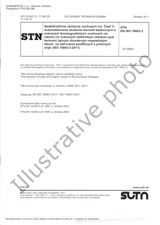We need your consent to use the individual data so that you can see information about your interests, among other things. Click "OK" to give your consent.

STN EN 60269-1 (354701)
Low-voltage fuses. Part 1: General requirements
STANDARD published on 1.3.2008
| Language | |
| Format |
|
| Availability | The sale has ended |
| Price | ONREQUEST excl. VAT |
| ON REQUEST | |
|
|
The information about the standard:
Designation standards: STN EN 60269-1
Classification mark: 354701
Catalog number: 105093
Publication date standards: 1.3.2008
SKU: NS-526070
The number of pages: 72
Approximate weight : 216 g (0.48 lbs)
Country: Slovak technical standard
Category: Technical standards STN
We recommend simillar standard:!
ČSN EN 60269-1 (01.06.1996)The category - similar standards:
Annotation of standard text STN EN 60269-1 (354701):
Táto časť IEC 60269 platí pre poistky obsahujúce uzatvorené obmedzujúce tavné vložky s menovitou vypínacou schopnosťou nie menšou ako 6 kA, určené na istenie obvodov na striedavý prúd sieťovej frekvencie, ktorých menovité napätie neprevyšuje 1 000 V, alebo obvodov na jednosmerný prúd, ktorých menovité napätie neprevyšuje 1 500 V.
These changes apply to this standard:
Change published on 1.4.2010
Selected format:Show all technical information.
Change published on 1.2.2015
Selected format:Show all technical information.
Similar standards:
WITHDRAWN
1.12.2001
1.7.2014
1.8.2001
WITHDRAWN
1.9.2012
1.9.2014
1.7.2010
We recommend:
Technical standards updating
Do you want to make sure you use only the valid technical standards?
We can offer you a solution which will provide you a monthly overview concerning the updating of standards which you use.
Would you like to know more? Look at this page.



 Cookies
Cookies
